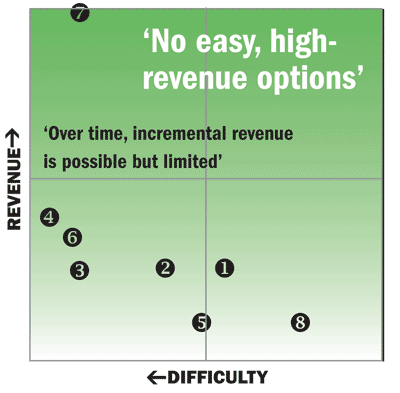CPB study sees no revenue alternative to replace federal appropriations
There’s scant hope of replacing public broadcasting’s federal funding with other revenue sources, according to preliminary findings of a study presented to the CPB Board April 11, 2011.
“The strong message here,” CPB President Pat Harrison noted, “is that the federal appropriation is the key.” If that funding drops off, “there isn’t a silver-bullet fix out there.”
Hamilton Place Strategies, a bipartisan policy and communications company hired by CPB, categorized the alternative funding options by revenue potential and difficulty. The consultants found no high-revenue, low-difficulty options.
They found only one high-revenue option, and establishing it would involve high difficulty: Earning cash by relinquishing public TV spectrum for the FCC’s proposed further auctions to wireless telecom companies. But that would mean giving up future multicasting opportunities (Current, Feb. 8, 2010).
“The reality is that revenue increases won’t make up for cuts in federal spending,” said Matt McDonald, a partner in Hamilton Place Strategies, former senior advisor to Sen. John McCain’s 2008 presidential campaign, and former McKinsey & Co. consultant. McDonald noted that any new cash would total “tens of millions, not hundreds of millions.”
The numbers show that the argument by some Capitol Hill lawmakers that pubcasting could simply raise its own money “is false,” Harrison said, “and if in fact that were possible, we’d be called commercial media. There’d be no CPB, no oversight.” The consultants advised that the system couldn’t earn enough funds even if policymakers relaxed restrictions on underwriting credits. Programming would have to be commercialized to the point that mission-driven content decisions would be impossible.
As part of the study’s first phase, to be completed this month, Hamilton Place looked at how stations have reacted to cutbacks thus far. Comparing their average 2008 and 2009 spending patterns, McDonald said, stations cut fundraising efforts by 7.5 percent; local production, 7.1 percent; general operating/administration, 5.2 percent; broadcast engineering, 4.4 percent; and other costs, 7.6 percent.
During the recession of 2009 and 2010, many stations did not amass a great deal of debt, said Mark Erstling, CPB senior v.p. for system development. They tended to cover revenue shortfalls by borrowing on short-term credit lines. “As stations move into 2011 and 2012,” he said, “it will be a lot more difficult for them to continue that cash flow.”
The second phase of the Hamilton Place Strategies research will propose reactions to various funding scenarios, including total loss of federal support. Researchers hope to estimate how many stations will close or cut back their activity and contribute less to the national systems.
Hamilton has also worked with CPB as a consultant to stations considering consolidation of services in Illinois and New York.
Comments, questions, tips?
Copyright 2011 American University

